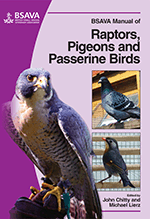
Full text loading...

‘Going light’ is a term used by breeders of passerine birds for those that are losing body condition with a few (or often no) outward signs. This chapter looks at macrorhabdus ornithogaster; coccidial diseases and general recommendations.
Passerine birds: going light, Page 1 of 1
< Previous page | Next page > /docserver/preview/fulltext/10.22233/9781910443101/9781910443101.35-1.gif

Full text loading...



